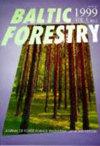Effect of altitude differences on seed germination and seedling growth in Rhododendron luteum Sweet
IF 0.6
4区 农林科学
Q3 FORESTRY
引用次数: 0
Abstract
The aim of this study is to encourage the use of Rhododendron luteum Sweet, distributed in high altitudes in its natural habitat, in planting designs and landscape architecture and to cultivate these plants by seed propagation. In this context, the effects of different altitudes on R. luteum germination and post-germination seedling growth were investigated. The germination success of R. luteum seeds collected at 3 different altitudes, 1,586 m, 1,760 m and 2,100 m a.s.l., was investigated under greenhouse conditions at a temperature of 25 ± 2 °C and humidity of 70 ± 2% and in soil, peat, soil + peat (5:5), peat + sand (7:3), soil + sand (7:3) and soil + peat + sand (4:4:2) propagation media. The post-germination seedling height, root length, and the number of leaves of the seedlings were determined. Different altitudes had significant effects (P < 0.05) on height, root length, and the number of leaves of the seedlings. The highest germination percentage was 76.69% with the seeds collected from 2,100 m. Furthermore, seedlings that grew from these seeds possessed the best seedling growth with a greater height, longer roots, and a greater number of leaves. Keywords: landscape architecture, Rhododendron luteum, seed propagation, variation海拔差异对黄杜鹃种子萌发和幼苗生长的影响
本研究的目的是鼓励在植物设计和景观建筑中使用分布在高海拔自然栖息地的黄体杜鹃,并通过种子繁殖来培育这些植物。在此背景下,研究了不同海拔对黄豆萌发和萌发后幼苗生长的影响。在温度为25±2℃、湿度为70±2%、土壤、泥炭、土壤+泥炭(5:5)、泥炭+砂(7:3)、土壤+砂(7:3)和土壤+泥炭+砂(4:4:2)的温室条件下,对采自海拔1586 m、1760 m和2100 m的黄体种子的萌发成功率进行了研究。测定幼苗萌发后的苗高、根长和叶片数。不同海拔对幼苗高、根长和叶片数有显著影响(P < 0.05)。在海拔2100 m处,发芽率最高,为76.69%。此外,由这些种子生长的幼苗具有最好的幼苗生长,具有更高的高度,更长的根和更多的叶子。关键词:园林;黄杜鹃;种子繁殖
本文章由计算机程序翻译,如有差异,请以英文原文为准。
求助全文
约1分钟内获得全文
求助全文
来源期刊

Baltic Forestry
农林科学-林学
CiteScore
1.60
自引率
0.00%
发文量
23
审稿时长
>12 weeks
期刊介绍:
The journal welcomes the original articles as well as short reports, review papers on forestry and forest science throughout the Baltic Sea region and elsewhere in the area of boreal and temperate forests. The Baltic Sea region is rather unique through its intrinsic environment and distinguished geographical and social conditions. A temperate climate, transitional and continental, has influenced formation of the mixed coniferous and deciduous stands of high productivity and biological diversity. The forest science has been affected by the ideas from both the East and West.
In 1995, Forest Research Institutes and Universities from Estonia, Latvia and Lithuania
joined their efforts to publish BALTIC FORESTRY.
 求助内容:
求助内容: 应助结果提醒方式:
应助结果提醒方式:


